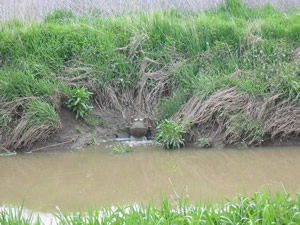


As you continue our tour on the south side of the swamp, you begin to realize that the Loblolly Marsh wasn't always a productive wetland as it is today and as it was 125 years ago. For approximately 100 years, the area now known as the Loblolly Marsh was a farm field. Throughout this time, the field was often covered with water, causing crop damage. In 1997, the Limberlost Swamp Remembered group established the Loblolly Marsh Wetlands Preserve with the help of community sponsors.
 The
transition from farmland to wetland does not happen overnight. The first
step is to remove portions of the main drainage tile. By removing or
blocking this portion of the tile, water will no longer flow easily
off the property.
The
transition from farmland to wetland does not happen overnight. The first
step is to remove portions of the main drainage tile. By removing or
blocking this portion of the tile, water will no longer flow easily
off the property.
If needed, native grasses and woody plants are planted
onto the reclaimed site. In many cases reseeding is not necessary
on former wetlands as seeds can still be found in the soil. The
seeding process is long and arduous but well
worth the work when the
plants begin to grow during the next growing season.

Links:
Limberlost
Swamp Restoration Dedication
Loblolly Marsh Wetlands Preserve Sponsors:
- Indiana Heritage Trust
- Ropchan Foundation
- ACRES, Inc.
- M.E. Raker Foundation, Inc.
- The Lawton Doll Company
- The Dr. John W. Flory Foundation
- George M. and Christine Plews
- Sycamore Audubon Society
The Loblolly Virtual Nature Trail was created as a part of the Our Land, Our Literature website.
